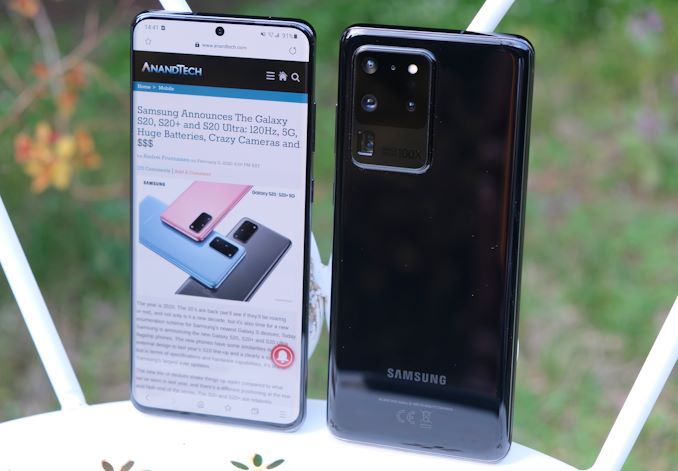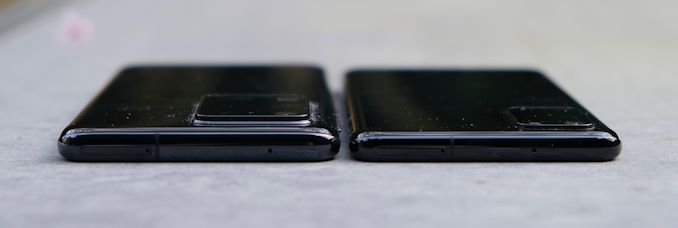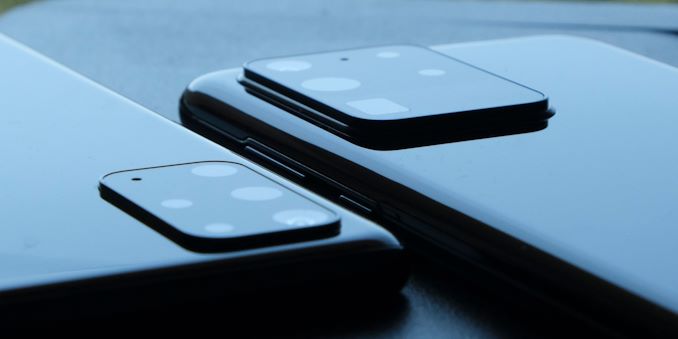The Samsung Galaxy S20+, S20 Ultra Exynos & Snapdragon Review: Megalomania Devices
by Andrei Frumusanu on April 3, 2020 9:30 AM ESTDesign, Continued: An Ultra Mega Phone
Of course, the flagship entry in the 2020 Galaxy line-up is the Galaxy S20 Ultra. Samsung here literally supersized the design, making a much larger and heftier version that goes beyond what the “regular” plus models offer. While the S20+ fits in the same form-factor as the S10+, the S20 Ultra is clearly a bigger phone, more in line with the behemoth that was the rare S10 5G.
The biggest differences in the design aren’t found in the front of the phone – here the Ultra essentially just looks the same as the other two S20 devices and you’d be hard pressed to tell them apart other than their size. Turn it around though, and you’ll see the Ultra’s enormous camera housing that is very distinct from any other phone on the market.
The first thing you’ll notice when handling the Ultra, beyond it having a larger footprint, is that it’s clearly a thicker phone. It’s 1mm thicker than the S20+, which is a 12.8% increase and is very noticeable. The sides of the phones are still curved as on the S20+, however the curve is now deeper, and the metal frame on the side of the phone is a sliver thicker than on the smaller variants.
The ergonomics are still good for a phone of this size, but of course, you’ll need to be used to having a phone this size.
Another aspect where the S20 Ultra just outsizes the S20+ is in terms of weight. At 220g, the phone is much closer in weight to an iPhone Max than it is the lighter, 187g S20+. With the weight does come a larger battery, which is now 5000mAh (typical capacity), an 11% increase over the S20+’s 4500mAh capacity.
Then there’s the camera bump of the Ultra. There’s no better word to describe it other than "enormous". The problem here isn’t that Samsung had to extend the camera housing thickness in order to integrate the complex camera modules and optics which the Ultra offers, but that they did so in what I find to be a very boring and ugly manner.
Most notably, the rim of the camera housing is just a raised metal element that protrudes out, which is in contrast to the curved design of the rest of the phone. Samsung probably decided that leaving such a big protrusion doesn’t look so good, so they added in another step in the frame between the glass back and the full protrusion – best way to describe it is that it looks like a gasket. The whole thing just looks very cheap and doesn’t compare to the filleted glass design from Apple or even the filleted “gasket” that Huawei uses in the recently announced P40 Pro. My biggest pet peeve about Samsung’s design is that it’s super prone to collecting dust in the three grooves around the camera – both of my S20 Ultras are full of it right now as I’m writing this. It feels like a rushed design with very little manufacturing refinement.
One other difference I noticed is in the speaker audio quality. The S20 Ultra does sound fuller and a bit less high pitched, probably due to the larger internal reverberation space of the design. It’s the better sounding phone of the S20 series.
Whether the S20 Ultra can justify its existence will largely depend on how its special camera hardware will be able to differentiate itself from the S20 and S20+. In terms of design, other than it being a big phone, I do think Samsung somewhat missed the mark with the camera housing. A filleted edge of the camera protrusion could have done wonders, so hopefully it’s something that the company will look into for future designs.














137 Comments
View All Comments
StrangerGuy - Wednesday, April 8, 2020 - link
$1400? Geez, I thought $1100 for the Ultra here in Singapore was already stupid overpriced especially when all S20 variants here are only available in 128GB and the Note 10+ 256GB is just $590.Cliff34 - Friday, April 3, 2020 - link
When I upgraded from s3 to s7, I was so impress by the new phone. Long battery life, great camera and fast cpu.Now I upgraded to s20+ and instead of feeling the aww feeling, I'm more like meh.
It comes w great features but they are all come w a cost. Great camera but if you take 64meg photos, it takes a few seconds to process. Great screen but if you switch on 120 hertz, your battery drains fast.
Hindsight, s20 is good enough for me.
philehidiot - Friday, April 3, 2020 - link
This is why I simply won't buy a new phone until I've waited for the Anandtech review. It takes a long time to come out and even longer to read but it has saved me a few bad decisions and premature upgrades. As well as a tonne of cash. I'm still on my S8 and the missus is on the S7 and y'know what? They're just fine. My only issue with the S8 is a recent update which is resulting in markedly increased screen brightness when set to auto. Try and drag the brightness back down and it just goes back up again. I can only imagine that "feature" was added to convince people it's time to upgrade. The only other issue is a bit of lag here and there but it's not a massive issue. I'm in the UK, so I absolutely will NOT pay Samsung for a product that is so inferior to other markets but they market and expect me to value exactly the same. I'm no problem with different internals for different markets and I've no problem with parts being sourced from different suppliers. BUT, you either change the price to reflect the value or you keep the specs of the different parts near enough the same if you want the value to be the same.Now, if you'll excuse me, for some strange reason my middle finger has gone stone cold and needs a rest. As if the blood has drained from it as a result of spending so much time erected in Samsung's direction.
phoenix_rizzen - Friday, April 3, 2020 - link
Install Lux and let that manage the auto-brightness. On the S6, S7, and A8 (2018), Lux does a much better job managing brightness than Samsung's settings. And you can set your own targets for "at this level of ambient light, set the brightness to this level", which is especially handy for lower light levels.On the S10e, I haven't bothered to install Lux, as Samsung's Adaptive Brightness eventually catches up to my preferences and is working well enough.
philehidiot - Friday, April 3, 2020 - link
Ahh sweet, cheers! I'll have a look at that now. The adaptive brightness has worked fine for several years and only since an update has it gone very strange.shabby - Friday, April 3, 2020 - link
Can all the cameras on the s20+ record in 4k60fps? In the s10 only the main one could so you couldn't record in 4k60 while switching between the sensors.Andrei Frumusanu - Friday, April 3, 2020 - link
It's unfortunately still only limited to the main camera module.shabby - Friday, April 3, 2020 - link
Damnitiamlilysdad - Friday, April 3, 2020 - link
While waiting for display accuracy comparison charts, can you post "old style" dE results so we can do our own comparisons? Or, even better, provide a timeline and list of devices that you're going to go back and retest using the new methodology/rating system?FunBunny2 - Friday, April 3, 2020 - link
I'm not a phone junkie, doh!, but isn't refresh rate tied to content/application coding? IOW, only content/applications written to display at 120 will benefit? Otherwise, won't the screen just refresh twice on the 60hz line?